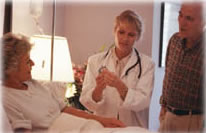


   |
Bites And Stings From Marine CreaturesOnly the most dangerous marine creatures are described here. There are many other types of stinging and biting sea creatures, including sharks. In general, bites and stings should be bathed with hand hot water, and then a cold compress should be applied to relieve pain. If swelling and pain become worse, or if muscle weakness or other symptoms develop, seek medical aid without delay. Cuts and scratches from shells and coral are prone to become infected. Clean them with antiseptic, and if swelling, redness, pain or infection develops, see your doctor. WarningNever walk barefoot through tropical waters or around reefs. when wading through shallow water, shuffle your feet through the sand; most biting creatures, especially those that rest on the sandy bottom, will flee if their surroundings are disturbed. Box jellyfish (marine stinger, sea wasp)These live in tropical waters around northern Australia. Because they breed in river mouths, they are only found close to the shore. Their fully grown bodies are as big as a 9 litre bucket. The tentacles that stream from the bottom of the body are covered with millions of stinging capsules. when a swimmer bumps into this jellyfish, the thin, ribbon-like tentacles tear off, stick to the victim's skin and inject their poison into the body. An extensive sting can be lethal, but antivenom is available. Signs and symptoms
First aid treatment
WarningAlways check with local authorities whether it is safe to swim in tropical waters. Look for tropical stinger warning signs on beaches. Blue bottle (Pacific or Portuguese man-of-war)This common jellyfish is found in warm seas around the world. The arrival of blue bottles in summer closes many beaches. The bright blue bodies carry tentacles up to 10 m long. Contact with tentacles can cause a painful sting, but nowhere near as painful or dangerous as the sting of the box jellyfish. First aid treatment
Blue-ringed octopus and cone shelfThe blue-ringed octopus is found in rock pools around the entire Australian coastline. It has dull yellow-brown bands and blue circles on its body and tentacles; when it is disturbed its colors darken and the rings become bright peacock-blue. This octopus is only about 20 cm across when its tentacles are spread out. Because it is small and attractive, children may be tempted to pick one up. They should be warned not to do this, and not to put their fingers in rockpool crevices or in empty soft drink cans found on the sea bed or in rock pools. Most cone shells (Conus species) live in tropical waters around northern Australia. The shells are often very beautiful and people love collecting them, but if their owner is alive it will bite! Always use tongs or thick leather gloves if you wish to collect and clean cone-shaped shells. The poison is injected by many little dart like spines around its mouth. All species are poisonous; the sting of some is lethal.The blue-ringed octopus will only bite if it is picked up or otherwise disturbed, and its bite is often painless. Cone shell bites are generally very painful. The venom of both has the same effects. It is potent and works rapidly. No antivenom is available. Signs and symptoms
First aid treatment
|
Online Doctor || Contact Us || Skin Disorders || Diabetes Care || Cellulite Guide || Chemotherapy ||
|
|
(c) Online-family-doctor.com All rights reserved
Disclaimer: Online-family-doctor.com is an information and educational purposes web site only. It is not intended to treat, diagnose, cure, or prevent any disease. Do not rely upon any of the information provided on this site for medical diagnosis or treatment. Please consult your primary health care provider about any personal health concerns. We will not be liable for any complications, or other medical accidents arising from the use of any information on this site.